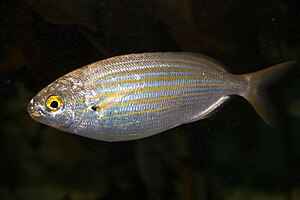Gold welt
| Gold welt | ||||||||||||
|---|---|---|---|---|---|---|---|---|---|---|---|---|

Gold welt ( Sarpa salpa ) |
||||||||||||
| Systematics | ||||||||||||
|
||||||||||||
| Scientific name of the genus | ||||||||||||
| Sarpa | ||||||||||||
| Bonaparte , 1831 | ||||||||||||
| Scientific name of the species | ||||||||||||
| Sarpa salpa | ||||||||||||
| ( Linnaeus , 1758) |
The Goldstrieme ( Sarpa salpa ), also called Goldstriemenbrasse , is a representative of the sea bream and the only species of the genus Sarpa . Colloquially, the species is also called Ulvenfresser, as it also eats sea lettuce ( Ulva lactuca ). Their distribution area extends in the eastern Atlantic from the Bay of Biscay to the coasts of Sierra Leone . It is also at home in the Mediterranean and Black Seas and in the coastal waters around South Africa . Although mostly marine, it also visits brackish water areas and estuaries.
features
The body of the gold welt, which is covered with ctenoid scales , is elongated-oval in shape and flattened at the sides. Your mouth is terminal. The relatively large eyes have a golden iris . It is named after ten to twelve yellow or gold-colored lines that run along the silver-gray sides of the body. There is a black spot over the base of the pectoral fins . The pelvic fins are on the chest, the caudal fin is clearly notched. The gold streak bears 68 to 78 scales along the sidelines . The species reaches a size of 30 cm, rarely up to 51 cm. The weight can be 1400 grams.
- Fin formula : dorsal XI − XII / 13−15, anals III / 14−15, pectorals I / 5
behavior
The Goldstrieme is a very sociable species and usually moves around in groups or larger swarms. Gold welts are very calm swimmers, but they remain in constant caution. In the event of danger or disturbance, the animals quickly seek out deeper regions or move away towards the open water. The species is diurnal. Often other fish like bream and parrotfish swim around with gold streaks.
habitat
The species is mostly to be found on rocky and sandy soils, as well as seagrass meadows. It is not uncommon for them to swim in schools in open water. The depth range moves from the water surface to a maximum depth of 20 m. In individual cases, Sarpa salpa can also be found at depths of up to 70 m.
nutrition
The adults are pure herbivores. The gold strip feeds mainly on Neptune grass ( Posidonia oceanica ) and other algae. These include the sea lettuce ( Ulva lactuca ) and the feathery red alga ( Laurencia pinnatifida ). The species also ingests phytoplankton . In certain regions it happens that the Goldstrieme consumes the so-called "killer alga" Caulerpa taxifolia . This species was introduced into the Mediterranean and has spread rapidly in some regions. Since the alga is toxic, the flesh of the gold streak also becomes toxic. The toxins accumulate in the tissue over time, making the meat unsuitable for human consumption. Caulerpa taxifolia's venom, when consumed by humans, can cause motor disorders, hallucinations and nightmares. Scientific studies have been carried out on the subject. The young fish of the Sarpa salpa feed mainly on small invertebrates such as shellfish and small crustaceans.
Reproduction
At a size of approx. 20 cm, the animals are able to reproduce. They are initially sexually mature as males, but later transform into females (protandric hermaphrodites). Under protandry refers to a special type of hermaphroditic. However, sex reassignment only takes place if the entire sex ratio is to the disadvantage of the male animals. Reproduction takes place in spring and autumn. The hatched brood and the eggs are planktonic.
Possible confusion
Possibly the species can be confused with the yellow welt ( Boops boops ). However, this is much slimmer and has only 3 - 5 longitudinal stripes, which are also clearly less colored.
literature
- Andreas Vilcinskas : Fish . 2nd Edition. BLV Verlagsgesellschaft, Munich 2000, ISBN 3-405-15848-6 (BLV regulation books). P. 132
- Bergbauer - Humberg: What lives in the Mediterranean? Franckh-Kosmos Verlags-GmbH & Co.KG, Stuttgart, 2009, ISBN 978-3-440-11736-1
- Guido G. Lanfranco: The Fish around Malta , Progress Press Co. Ltd. Malta, 1993
- Lawson Wood: Sea Fishes And Invertebrates Of The Maltese Islands and The Mediterranean Sea
- Claus Valentin: The fascinating underwater world of the Mediterranean, Pacini Editore srl Pisa, 1986
Individual evidence
- ^ Bent J. Muus, Jørgen G. Nielsen: The marine fish of Europe in the North Sea, Baltic Sea and Atlantic. Kosmos, Stuttgart 1999, ISBN 3-440-07804-3 , p. 192.
- ↑ Genus Sarpa on Fishbase.org (English)
- ↑ http://www.wissen.de/lexikon/goldstriemen
- ↑ a b Goldstrieme on Fishbase.org (English)
- ↑ a b c Bergbauer - Humberg: What lives in the Mediterranean? Franckh-Kosmos Verlags-GmbH & Co. KG, Stuttgart, 2009, ISBN 978-3-440-11736-1
- ↑ http://www.marinespecies.org/aphia.php?p=taxdetails&id=127064
- ↑ Luc De Haro, Philip Pommier: Hallucinatory Fish Poisoning (Ichthyoallyeinotoxism): Two Case Reports From the Western Mediterranean and Literature Review. Clinical Toxicology 2006, Vol. 44, No. 2, October 2006 ( doi : 10.1080 / 15563650500514590 ; accessed October 14, 2017).
- ↑ tierdoku.com
- ↑ http://tierdoku.com/index.php?title=Goldstrieme
Web links
- Goldstrieme on Fishbase.org (English)


